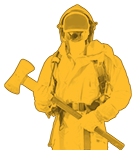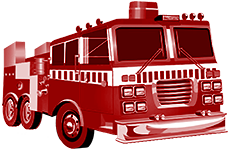
Home Fire Prevention
More than 3,500 Americans die each year in fires and approximately 20,000 are injured. An overwhelming number of fires occur in the home. There are time-tested ways to prevent and survive a fire. It’s not a question of luck. It’s a matter of planning ahead.
Further information is available on the U.S. Fire Administration Home Fire Prevention web site.
Smoke Alarms
A properly installed and maintained smoke alarm is the only thing in your home that can alert you and your family to a fire 24 hours a day, seven days a week. Whether you’re awake or asleep, a working smoke alarm is constantly on alert, scanning the air for fire and smoke.
Further information is available about Smoke Alarms on the U.S. Fire Administration Smoke Alarm web site.
Carbon Monoxide, the Invisible Killer
Each year in America, unintentional carbon monoxide poisoning claims more than 400 lives and sends another 20,000 people to hospital emergency rooms for treatment.
Further information is available concerning Carbon Monoxide dangers on the U.S. Fire Administration Carbon Monoxide website.
Home Fire Escape Plans
Fire can spread rapidly through your home, leaving you as little as two minutes to escape safely once the alarm sounds. Your ability to get out depends on advance warning from smoke alarms, and advance planning — a home fire escape plan that everyone in your family is familiar with and has practiced. Further information is available from the National Fire Protection Association and U.S. Fire Administration Escape Planning sites.
Children may enjoy Sparky’s website.
Address Signs
Accidents and fires happen. When these emergencies occur, precious seconds that are lost trying to find an address can mean the difference between life and death. Do everything you can to help increase your odds — place a highly visible address sign at the end of your driveway and on your home.

As a minimum there should be big, highly visible, reflective, house numbers (at least 4″ tall) on your home and at the entrance of the driveway onto the street.
You may need to have more than one address sign if you live on a private access road. We do not know which house you live in when there is a “Y” at the end of the driveway. Place additional address signs at the end of your access road or driveway and then on your home to assist us in reaching you.
Please remember to keep all brush and grass cleared from around your rural address sign, if we cannot see the sign, we cannot find you.
You can obtain the materials to install a new address sign or replace your non-reflective address sign from many of the local hardware stores or from online vendors at a very reasonable price.
Driveway and Private Road Access for the Fire Department
Can a fire truck or ambulance get to your home? Whether to provide emergency medical services or a structural fire, firefighters and EMT’s must be able to get equipment to the scene. Rural homeowners constructing homes several hundred or thousands of yards from the road must keep in mind that a fire truck is large and heavy, and has a wide turning radius.
Driveways should be at least 12 feet wide and 14 feet of overhead clearances to allow a fire truck or equipment to pass through. This not only includes clearance between trees and limbs along the drive, but also between brick pillars, gates, and statues that might be present at the entrance to the drive. Gate openings should be at least 2′ wider than the roadway.
Culverts under the driveway, private bridges, and the road surface should be able to support the weight of a 20-ton vehicle. Fire trucks loaded with water are heavy.
Grades (slope) should not be greater than 10 percent and should be designed to prevent pooling of water on the road surface.
Driveways over 200 feet (about 70 paces) should have a turn-around of no less than 50′ radius. The turn-around should be within 50 feet of the buildings. Do not expect a fire truck to turn around in the lawn as the ground could be soft. Remember that they might need to go back and get more water. You want them to do that quickly.
Road/street addresses should be clearly marked in block letters/numbers so that fire fighters can easily find the home. (Note: This also works well for the pizza guy.)
Rural Water Supply for Fire Protection
In rural areas, a lack of water mains and pressurized fire hydrants can sometimes impair a fire department’s ability to do its job quickly and efficiently. The success of a fire departments operation hinges on the distance a truck must travel to fill-up and return to the fire. In many cases these fill-up points are often long distances from the fire and the firefighters are unable to maintain an uninterrupted water source at the scene.
Keeping this challenge in mind Fauquier County Fire Companies have established multiple Rural Water Supply fill sites. These fill sites are either dry hydrants or ponds/creeks with safe access for a 20 ton fire truck.
If you are interested in assisting Warrenton Volunteer Fire Company by installing an access road, dry hydrant, or fire cistern, please contact the Fire Chief.
Home Disaster Preparedness
www.ready.gov
Get A Kit –You may need to survive on your own after an emergency. This means having your own food, water, and other supplies in sufficient quantity to last for at least three days. Local officials and relief workers will be on the scene after a disaster, but they cannot reach everyone immediately. You could get help in hours, or it might take days. In addition, basic services such as electricity, gas, water, sewage treatment, and telephones may be cut off for days, or even a week or longer.
Make A Plan –Your family may not be together when disaster strikes, so it is important to plan in advance: how you will contact one another; how you will get back together; and what you will do in different situations.
Be Informed –Some of the things you can do to prepare for the unexpected, such as making an emergency supply kit and developing a family communications plan, are the same for both a natural or man-made emergency. However, there are important differences among potential emergencies that will impact the decisions you make and the actions you take. Learn more about the potential emergencies that could happen where you live and the appropriate way to respond to them.
Local Business Pre-Incident Planning
To increase our readiness for possible emergency incidents in the community, we are asking businesses throughout the community to develop pre-fire incident plans. The purpose of these plans is to record information about the businesses in advance so that firefighters will know the best way to extinguish a fire in a particular building or handle other emergency situations. These surveys will be developed into comprehensive plans that in advance inform firefighters of areas of a building that are vital to a business and its ability to function as well as the building’s construction, the location of hazardous materials and the building’s floor plan. If you have further questions, please contact us.
Car Seats Statement
Warrenton Volunteer Fire Company does not install car seats. Please visit the Fauquier County Sheriff’s Office or Warrenton Police Department for installation.


